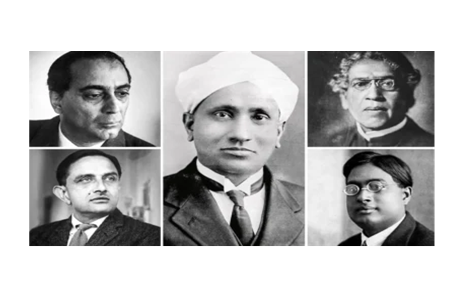- Home
- Up to XII Students
- Decide Stream For XI & XII
- Career Options
- Entrance Preparation
- Sample Papers
- Entrance Exams after 12th
- International Entrance Exams To Study Abroad
- Foreign University Comparison
- Apply to Foreign Universities
- General Preparation For Students Going To Study Abroad
- Write A Report
- Write an Article
- Write An Essay
- Important Dates
- UG & PG
- Tech Tips
- Mock Test
- GROOMING
- HOBBIES
- K PLUS
- Working Professional
- OTHERS
Indian Physicists and Their Contribution
India has a long and proud tradition of physicists, with some of the earliest contributions in the field dating back thousands of years. The most notable of these is likely the ancient Indian mathematicians and astronomers who developed the mathematical sciences such as the decimal system and created influential texts such as Surya Siddhanta, the earliest known geological survey of India, as well as the Panchasidhanta, a treatise on astronomy.
Ancient Indian physicists were some of the world’s most advanced and knowledgeable people. They used the knowledge they obtained through intense study to make discoveries that would eventually lay the foundation for modern physics. Indian physicists have contributed to various branches of physics, such as optics, acoustics, cosmology, and astronomy. Their contributions diligently enabled the ancient Indians to make advancements in multiple areas of science.

Aryabhata
was one of the most prominent Indian physicists in the 5th century. He
developed the heliocentric theory of the Solar System, which proposed that the
sun was the centre of the universe, not the Earth. He also developed a method
for calculating the value of pi and the circumference of a circle, which are
still used in today’s mathematics courses.
Brahmagupta
was the first physicist to identify the use of zero in Indian mathematics. His
book, Brahmasphutasiddanta, explained the basics of mathematics, such as
addition, subtraction, multiplication, division, trigonometry, and geometry.
This book became the foundation of all modern mathematical knowledge.
Sushruta
was an ancient Indian physicist who invented some of the earliest medical
devices. He designed cataract surgery, the first medical procedure of its kind.
He also developed instruments and techniques for performing various other
surgeries, which are still used today.
Bhaskara
was another influential ancient Indian physicist. He developed theories of
planetary motion and solar eclipses and described astronomical phenomena like
comets and stars. He also formulated ideas about gravitational attraction and
the movement of celestial bodies.
These
ancient Indian physicists made several significant discoveries and
significantly advanced the field of physics. Their findings helped shape modern
physics’s development, and their legacy still influences our understanding of
the universe today.
Indian
physicists have made immense contributions to physics in the 20th century.
These contributions range from advances in condensed matter and nuclear physics
to breakthroughs in particle physics, cosmology, and astrophysics.
Jagadish
Chandra Bose (1858-1937) is regarded as India’s pioneer of modern physics. His
most important contribution was radio communication, for which he became the
first to use a semiconductor junction. He also discovered the ionization of
gases by thunder, which paved the way for the later development of radar. In
addition, he pioneered studies of X-rays, infrared radiation and microwave
radiation. His work in physics laid the foundation for many of the modern
techniques.
Meghnad
Saha (1893-1956) was an Indian astrophysicist who developed a theoretical
equation, now known as the Saha equation, which describes ionized gases’
chemical and thermal equilibrium. He also hypothesized the stars’ structure and
discovered the radiative equilibrium concept in stellar interiors. His work
revolutionized our understanding of stellar evolution and cosmology.
Satyendra
Nath Bose (1894-1974) is best known for his work with Albert Einstein on the
theory of Bose-Einstein condensates (BEC). Bose proposed that particles like
photons, atoms, and electrons should have particle-like as well as wave-like
properties. This concept contradicted the accepted law of nature at the time.
He was the first to propose the statistical effects of multiple particles
behaving as one, which paved the way for the development of quantum theory and
statistical mechanics.
Subrahmanyan
Chandrasekhar (1910-1995) was an astrophysicist and Nobel Laureate who made
great strides in understanding the structure and evolution of stars. He
proposed the Chandrasekhar limit, which states that a star with a mass greater
than 1.4 solar masses can collapse into a black hole. His work has had a
lasting impact on modern astrophysics.
These
physicists laid the foundation for further advancements in Physics in India.
Their insights and contributions have paved the way for further research and
innovation in the field. Due to their dedicated work, India boasts a growing
number of physicists and academics making valuable contributions to Physics.
Dr.
Avinash Singh
Assistant
Professor
Department
of Physics,
Kalinga
University, Naya Raipur (C.G)

Kalinga Plus is an initiative by Kalinga University, Raipur. The main objective of this to disseminate knowledge and guide students & working professionals.
This platform will guide pre – post university level students.
Pre University Level – IX –XII grade students when they decide streams and choose their career
Post University level – when A student joins corporate & needs to handle the workplace challenges effectively.
We are hopeful that you will find lot of knowledgeable & interesting information here.
Happy surfing!!
- →
-
Free Counseling!
